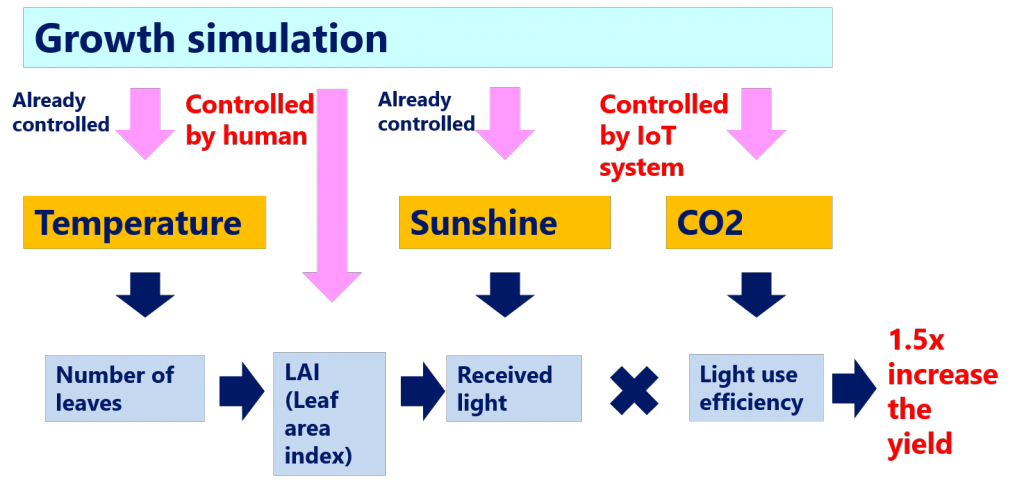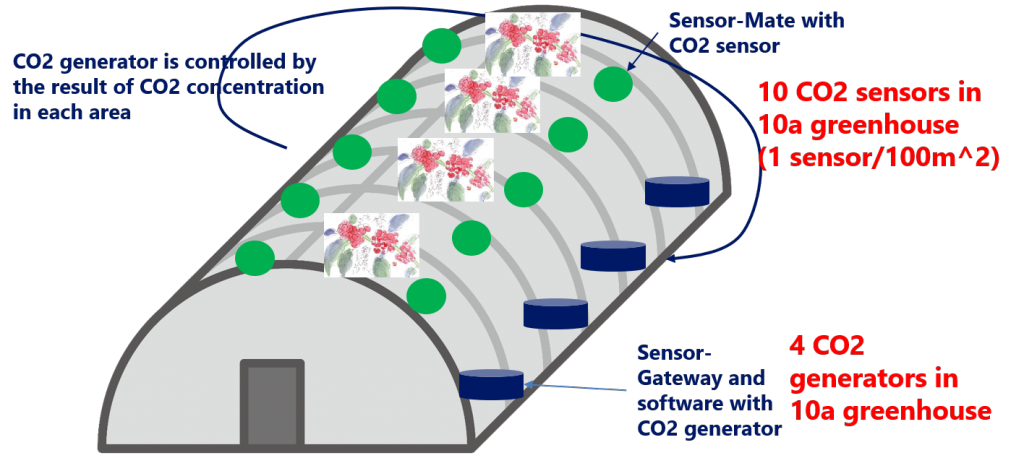Improve agricultural profits by introducing autonomous IoT

Value creation by IoT
What kind of value can be created by utilizing IoT?
Typical cases are following.
- Profit improvement support
- Maintenance cost reduction
- Resolving labor shortage
We would like to take a look at how tomato farmers support profit improvement in greenhouse farming, regarding profit improvement by IoT systems. This is an example of aiming to improve profitability through IT agriculture and precision agriculture.
Example of simulation for improving profitability of tomato farmers
Suppose a tomato farmer wants to increase the yield of tomatoes in greenhouse cultivation. The current yield is 10a / 25t every year, and he wanted to increase this by 1.5 times to 10a / 37.5t.
When he thought about what is the improvement point for the yield, he focused on optimizing the CO2 concentration. For example, he are currently not controlling the CO2 concentration, but he will aim to increase the yield by controlling the CO2 concentration in the house with an IoT system.

The figure above is a growth simulation of a tomato farmer.
Control of temperature and amount of sunshine is also necessary for plant growth. In addition to this, controlling the concentration of CO2 that acts directly on the plant in the house increases the potential for increased yields.
- CO2 concentration is currently uncontrolled
- Leaf Area Index (LAI) is possible by controlling the temperature
- The amount of sunshine is already optimal due to the structure of the house.
- The temperature is already optimally controlled by the air conditioner
The conclusion was that the yield could be increased by 1.5 times by precisely controlling the CO2 concentration.
He thought that this could be achieved by building an IoT system.
CO2 monitoring and control system by autonomous IoT system

This system is a system that constantly monitors the CO2 concentration by IoT and automates the control by the CO2 generator.
A large number of sensor nodes equipped with CO2 sensors are placed in the house to measure the CO2 concentration.
Then, the data is wirelessly transferred to the Gateway.
The Gateway wirelessly controls the CO2 generator, which is an actuator, based on the obtained CO2 concentration.
If he consider a profit and loss statement when this system is introduced, it is thought that fixed costs, depreciation costs, fuel costs for operation, labor costs, etc. due to the introduction of CO2 generators will increase, but the yield will increase 1.5 times. It is expected that the income will increase by 1.5 times. Depending on the size of the house, the simulation results show that he can make up for the increased costs and get more profit.
Actually, there are many other factors, so it seems that it is not such a simple calculation, but if CO2 concentration control by IoT is the key point of yield increase, autonomous IoT systems are very effective.
Key technologies for realizing autonomous IoT systems
The key technologies for realizing this system are size minimization, low power consumption, and low cost of CO2 sensors. In other words, by arranging a large number of CO2 sensors, it is possible to grasp more multifaceted situations and perform optimal environmental control.
Most of the current CO2 sensors consume a large amount of power and are expensive. It will become easier to introduce by reducing the power consumption to a level that operates at low cost and energy harvesting.
Tele-Sentient is a platform that can realize such an autonomous IoT system.
In addition, by connecting the AFE technology by Sensor I / F LSI and the sensor at the RAW level, we believe that an IoT system equipped with a CO2 sensor that satisfies these low cost and low power consumption conditions can be realized.
We are looking for a joint application development partner, Sensor I / F LSI development and manufacturing partner, which utilizes Tele-Sentient to realize such an autonomous IoT system.
If you are interested, please feel free to contact us.
